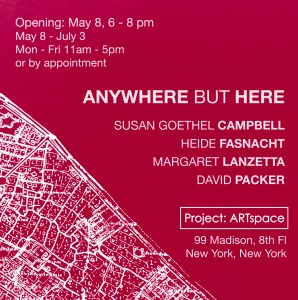
Contributed by�Becky Huff Hunter / In his influential Art in America article �Provisional Painting� (2009), critic Raphael Rubinstein traced a history�from Joan Mir� to Mary Heilmann�of �works that look casual, dashed-off, tentative, unfinished or self-cancelling,� that �constantly risk inconsequence or collapse.� In Rubinstein�s analysis, this attitude provides an easier yoke for artists tired of laboring under modern painting�s grand and burdensome history. Readers of this blog will also be familiar with parallel discussions of Casualist painting, a contemporary tendency to integrate the form�s traditionalism with improvisation, the off-kilter, and the seemingly offhand.�“Quicktime,” a concise group exhibition at the Rosenwald-Wolf Gallery of the University of the Arts, Philadelphia, adds to this expansive conversation with a focus on painterly speed, spontaneity, and time span.�
In the show, twelve recent, mostly large-scale, conventionally stretched works share fast-looking brush strokes; few visible layers of oil or acrylic; a graphic, flat appearance that emphasizes surface; and the impression�confirmed in the curatorial statement�that these paintings did not take long to make.

Amy Feldman�s acrylic-on-canvas paintings, Mars Arms and Sooty Sweat (both 2016), are daringly spare. They look as if Feldman toted a spray gun to achieve the flat grey grounds� uniform sheen and then, narrow brush in hand, repeatedly raised and lowered her arm to create simple chains of curvy shapes. Marina Adams�s similarly large scale but highly colored works flank Feldman�s in the gallery. With their glowing bright, harlequin-pattern blocks of thin wash over still-visible graphite guidelines, they appear like skeletons of�or sketches for�ambitious modernist works. Both artists works here display the qualities of what Rubinstein called �body doubles.�


Works by Patricia Treib and Melissa�Meyer have a calligraphic quality, reminiscent of the writerly gestures of Louise Fishman or the pictograms of Jane Irish, though these comparative examples bear the marks of having been worked over many times. Treib�s Camera (I) (2013) is a pared-down still life of a vintage-looking brown camera complete with zoom lens and, perhaps, books and a case. This photographic subject matter reflects on another kind of speed or immediacy in image making, and one that deeply impacted the field of painting.

The works in the exhibition raise the question, for me, of what it is that we value about painting right now�where we locate meaning and value in paintings made quickly. While asserting the ascendency of speed, the “Quicktime” curatorial statement betrays an anxiety about these works being perceived as purely provisional, casual, or fast�and immediately addresses this anxiety by emphasizing the opposite, namely long-term persistence in hard-won studio practice, paraphrasing Marina Adams: �it is not actual time that is needed to make a specific work, but the accumulated years of committed studio time.�



This shifting of where and when artistic labor happens feels pertinent at a time when funding for the arts is again under threat, younger artists still feel pressured to justify their choice of paint as medium, and we all feel wary about the exploitation of various forms of creative labor. Artists feel these practical pressures just as keenly as the imposing weight of art history. Under such fraught conditions, “Quicktime” proposes a position from which it is still possible to paint.
“Quicktime,” with Marina Adams, Amy Feldman, Ann Craven, Melissa Meyer and Patricia Treib. Rosenwald-Wolf Gallery at University of the Arts, Philadelphia, PA. through April 22, 2017.
About the author:�Becky Huff Hunter�is�an independent writer, editor, and researcher, who regularly covers Philadelphia-area contemporary art in�Artforum. She has�written for�Frieze,�Sculpture, and�Art Papers, as well as numerous exhibition catalogue essays,�and she works as�a staff writer at the University of Pennsylvania.
Related Posts:
Newness: Melissa Meyer at Lennon, Weinberg
Patricia Treib: Pieces
The Casualist tendency















I thought it was clearly documented that
Sharon Butler came up with the “casualist” rubric? I said as much in this blogpost: http://martinmugar.blogspot.com/2016/05/shake-and-bake-aesthetics-in.html
Craven’ s work reminds me of Alex Katz.
I also feel that the whole idea of this exhibit is ridiculous. There is no such thing as quick, casual or “provisional” painting. The art of painting should never be casual, quick or anything other than slow, deep thinking, and deliberate. Any other notion about it is demeaning.
Most of the work in this show is just dumb. Since when is dumb interesting and worthwhile?
I think the time taken to make Art is not relevant. It is the end result that matters. Often something can be labored over and the result is no good. Should the Artist be credited because of the time put into it. I think not.